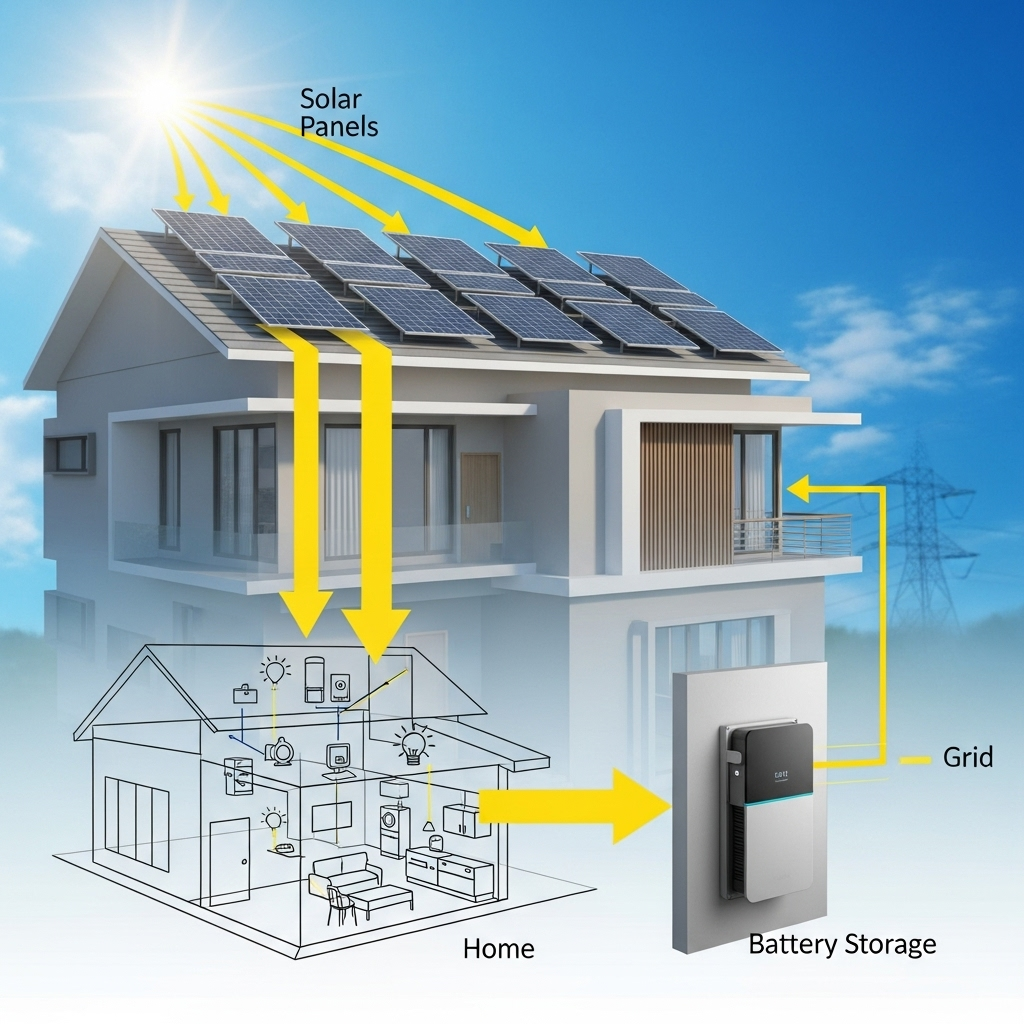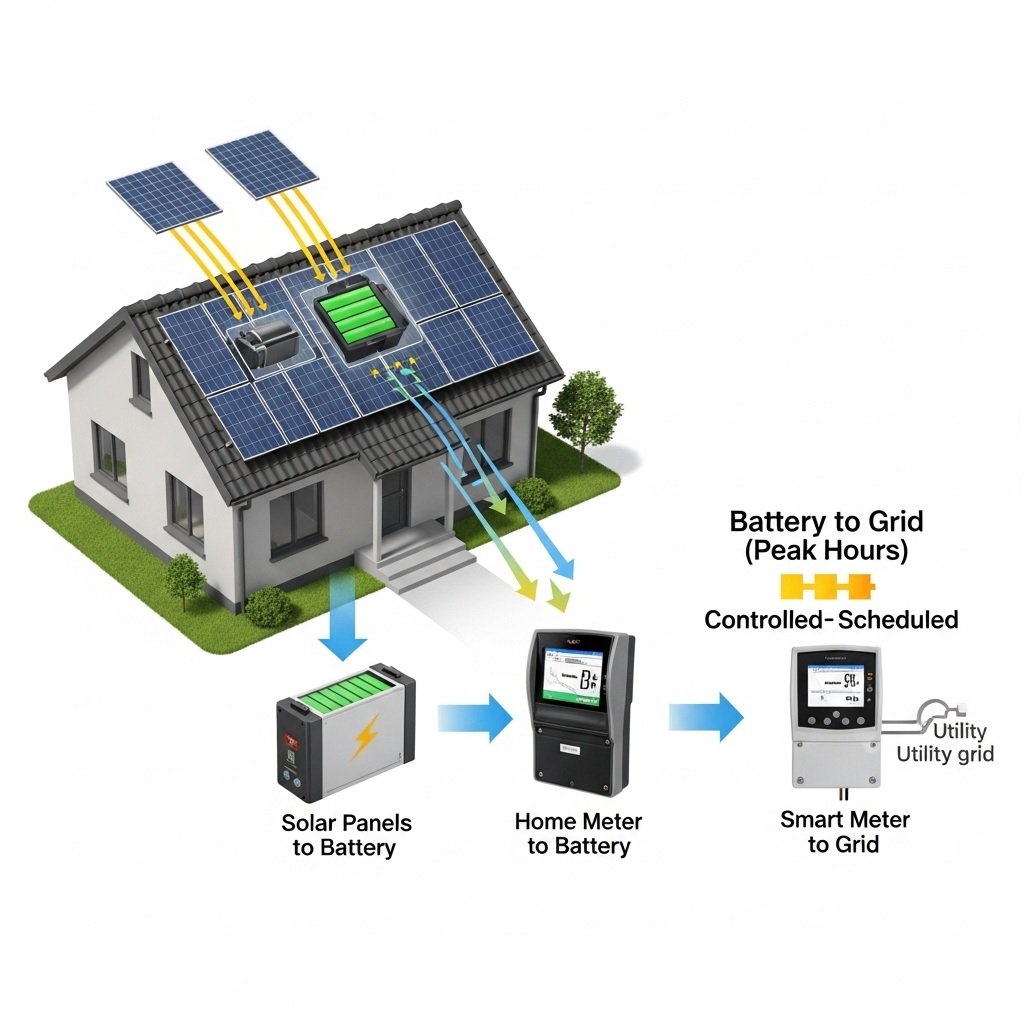Generating your own clean energy with a solar power system is an empowering step. You reduce your electricity bills and gain more control over your energy future. But before your panels can power your home and send excess energy back to the grid, you must navigate the critical process of interconnection. This process is governed by two key sets of regulations: grid connection standards and net metering rules. Understanding these regulations is fundamental to a successful solar installation. This guide will clarify these complex topics, providing the knowledge you need to connect your system with confidence.
Understanding Grid Connection: The Foundation of Your Solar System
Think of the electric grid as a complex, interconnected highway. Grid connection standards are the traffic rules that every generator, from a large power plant to your rooftop solar array, must follow. These rules ensure that all systems operate safely and harmoniously, maintaining the stability of the entire network.
What Are Grid Connection Standards?
Grid Connection Standards, often called "grid codes," are the technical and legal requirements for connecting a power-generating system to the public electricity grid. Their primary purpose is to ensure the safety of utility workers and the public, maintain the reliability of the power supply, and prevent your system from causing issues for other users. These standards are set by utility companies and regional regulators. The process typically involves a formal interconnection agreement, which is a contract between you and the utility that outlines the terms of your connection. For a deep dive into this topic, you can review The Ultimate Guide to PV Interconnection & Net Metering.
The Interconnection Process: From Application to Approval
Connecting your solar system to the grid follows a structured process. While specifics vary by location, the steps generally include:
- Application: You or your installer submit a detailed application to the utility, including information about your system's size and the equipment you plan to use.
- Technical Review: The utility's engineers review the application to ensure it meets all safety and technical standards. This is often where delays can occur. Following best practices can help you How to Pass PV Interconnection Screens Without Delays.
- Approval & Agreement: Once the review is complete, the utility grants approval and provides the interconnection agreement for you to sign.
- Installation & Inspection: After the agreement is signed, the system is installed. The utility then performs a final inspection before granting Permission to Operate (PTO).
Using high-quality, certified components, such as a reliable solar inverter that converts DC power from your panels to AC power for your home, can significantly streamline the technical review and approval stages.
Key Technical Requirements You Need to Know
The technical review focuses on how your system will behave while connected to the grid, especially during grid disturbances. Modern systems use advanced hardware to actively support the grid. Smart inverters, for example, can help manage grid voltage and frequency, which may reduce the need for expensive utility upgrades. Key technical standards, such as IEEE 1547, define these capabilities, and understanding them can lead to a Unlock Faster Grid Connection with IEEE 1547 Settings. Another critical function is fault ride-through, which ensures your system remains connected during minor grid faults, contributing to overall grid stability.
Net Metering Explained: Getting Credit for Your Power
Once your system is connected, net metering is the policy that allows you to receive fair compensation for the excess electricity you generate. It's one of the most significant financial incentives for installing a solar power system.
How Does Net Metering Work?
At its core, net metering is a simple billing mechanism. When your solar panels produce more electricity than your home is using, the surplus power flows out to the grid. Your utility meter tracks this outflow. When you use electricity from the grid (for example, at night), your meter tracks that inflow. At the end of the billing period, the utility "nets" the two amounts. You are only billed for your net consumption—the difference between the electricity you consumed from the grid and the electricity you sent to it. If you generate more than you use, you typically receive a credit on your bill.
Net Metering vs. Net Billing: What's the Difference?
As solar adoption has grown, many regions are transitioning from traditional net metering to alternative compensation structures, most commonly net billing. The primary difference lies in the value of the credit you receive for your excess energy. Understanding this distinction is crucial for calculating the financial return of a solar project. You can explore the financial impacts in more detail in this comparison of Net Metering vs Net Billing: Impacts on PV Interconnection.
| Feature | Net Metering | Net Billing |
|---|---|---|
| Credit Value | Full retail rate (1-for-1 credit) | Often a lower rate, such as wholesale or "avoided cost" rate |
| Financial Impact | Maximizes savings by directly offsetting consumption at the retail price | Reduces the value of exported energy, making savings less direct |
| Encourages | Maximum energy generation | "Self-consumption" – using the energy you generate on-site |
The Evolving Policy Landscape
The shift from net metering to net billing reflects a change in utility and regulatory thinking. The new policies are designed to encourage system owners to align their energy consumption with their solar production or to install battery storage. This transition changes the economic calculation for solar and storage systems, making energy independence even more valuable. It is important to stay informed about Q&A: What Net Metering Changes Mean for Solar-Plus-Storage.
The Role of Energy Storage in a Modern Grid
The evolution of net metering policies has made energy storage more than just a backup power source; it is now a key component for maximizing the value of your solar investment. A home energy storage system (ESS) allows you to store solar energy for use whenever you need it.
Why Pair Solar with Battery Storage?
Pairing solar panels with a battery system, like a robust solution built with high-performance LiFePO4 (Lithium Iron Phosphate) cells, offers several advantages. First, it allows you to maximize self-consumption. Instead of sending your excess solar energy to the grid for a low credit, you can store it in your battery and use it during the evening. This strategy directly counters the financial drawbacks of net billing and accelerates your journey toward energy independence. Second, it provides reliable backup power during grid outages, keeping your essential appliances running.
Navigating Interconnection with Solar-Plus-Storage
Adding battery storage introduces new factors into the interconnection process. Utilities need to understand how and when your battery will charge and discharge to ensure it doesn't negatively impact the grid. This involves navigating rules around operating schedules and export controls. While it can add complexity, many states are actively working to streamline these rules. With a properly designed system, you can avoid common 7 Net Metering Pitfalls in Hybrid PV-Storage Interconnection.
Performance Metrics for Your Storage System
When selecting a battery system, it's important to understand key performance metrics that determine its real-world value. As detailed in our guide on Understanding Solar Storage Performance Metrics, the most critical factors include:
| Metric | Definition | Why It Matters |
|---|---|---|
| Round-Trip Efficiency (RTE) | The percentage of energy put into the battery that can be retrieved later. | A higher RTE means less energy is wasted during the charge/discharge cycle. Modern LiFePO4 systems can achieve an RTE of 95% or more. |
| Depth of Discharge (DoD) | The percentage of the battery's total capacity that is used. | A higher DoD allows you to use more of your battery's stored energy. LiFePO4 batteries can typically handle a DoD of 90-100% without significant degradation. |
| C-Rate | The rate at which a battery is charged or discharged relative to its capacity. | This determines how quickly you can charge your battery or how much power it can deliver at once to start large appliances. |
Choosing a system with strong performance in these areas, like an integrated ESS that combines LiFePO4 batteries with a hybrid inverter, ensures you get the most out of your stored energy.
Advanced Topics and Future Trends
The world of renewable energy policy is constantly advancing. Staying aware of emerging trends can help you future-proof your energy system and make more informed decisions.
Zero-Export and Constrained Grids
In some areas, the local grid infrastructure may not have enough capacity to handle more exported solar energy. In these "constrained" areas, utilities may require zero-export systems. A zero-export configuration allows you to generate and use your own solar power on-site but prevents you from sending any excess power to the grid. This is another scenario where battery storage is invaluable. You can store all your excess generation for later use, ensuring no energy is wasted while still complying with utility requirements.
The Future of Grid Interconnection Rules
Regulators and utilities recognize the need to update their rules to better accommodate energy storage. Many states are actively updating their interconnection processes to create clearer pathways for solar-plus-storage systems. New tools like public hosting capacity maps are also becoming available, which show where the grid can easily accommodate new solar projects, helping to speed up approvals. As these rules evolve, achieving Blueprint for Grid Code Compliance in Residential PV-ESS will become more straightforward for homeowners.
Your Path to Energy Independence
Navigating grid connection standards and net metering policies is a fundamental part of any successful solar project. While the rules can seem complex, they are manageable with the right knowledge and equipment. The trend is clear: as policies evolve, direct self-consumption of your own solar power is becoming increasingly valuable.
By pairing your solar panels with a reliable and scalable energy storage solution, you place yourself in the best possible position to adapt to policy changes and maximize your energy savings. Understanding these rules is the first step on a rewarding path to achieving greater energy independence for your home or business.
Disclaimer: This article provides general information and is not intended as legal or financial advice. Grid connection and net metering rules vary significantly by location. Please consult with a qualified local solar professional and your utility company to understand the specific requirements in your area.





Leave a comment
All comments are moderated before being published.
This site is protected by hCaptcha and the hCaptcha Privacy Policy and Terms of Service apply.